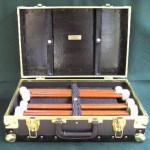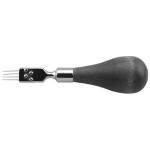My Instruments | A Timpanist’s Toolbox
NB: This post is mainly for those of you (and there are many) who wonder what a timpanist is and what is in that case (or cases) that he carries with him to rehearsals and concerts. To those of you who are already expert, consider this a peek into my “tool kit”. – AS
What’s in the case?
Ever wonder what tools a timpanist uses, other than the timpani themselves, and a pair of timpani mallets? Ever wonder just what is in those cases that the timpanist carries onstage with him? Of course, there are the various pairs of timpani mallets that the player will use during that particular series of rehearsals and concerts. However, in addition to the mallets, there are other tools in the case that the player considers essential to his task, and in this blog post, we’ll discuss these in detail, as well as the mallets. We’ll use my stick case as an example.
Mallets
I have several sets of mallets – about fifty pair, to be precise. Many of these mallets are ones that I have used over the course of my forty-plus year career. I keep these in relatively good shape in the event that I have need of them. These I call “legacy mallets”, and there are about thirty pairs of these. These are largely made up of Hinger, Andrew Feldman and other mallets that were designed for special circumstances. Then there are the other twenty pairs – these I call my “day-to-day” or “go-to” mallets. These are largely Ron Carlisle mallets – consisting of his Professional, Symphonic and Euro Lines, as well as specialty mallets.
There are far too many mallets for any one case to hold them, so I have several different cases to house them, as well as a specially built stick holder. This holds about twenty pair of sticks, mainly those that I use from time to time. The rest reside in normal stick cases – I have one Vic Firth case which houses my legacy mallets, and a Ron Carlisle case from the early 2000s which houses my go-to mallets – those which I use most frequently. I also have a smaller brief case which I use for church or chamber music gigs.
From the last statement, one can deduce that the type of musical service – be it a church gig, chamber orchestra concert, or standard symphony rehearsal/concert series – determines the case – or “tool kit” that I will be using.
Once I determine what type of service I have been contracted for, I put together my “tool kit.”
If I am playing a symphony concert cycle – a series of rehearsals culminating in a pair of concerts, I will use my Carlisle case. This is a case that is deep enough to hold at least ten pairs of mallets – more than enough to give me the options I need. The concert program will determine what goes into the bag. For this week’s program with the Illinois Philharmonic, the music of John Adams – “The Chairman Dances” – Lee Actor’s “Dance Rhapsody”, and the Symphony No. 12, “The Year 1917” by Shostakovich make up the program. I will be needing a variety of sticks – from soft to hard – with a preponderance of medium general to medium hard. For this program, I’ll put in the following as a general rule: Soft; Medium; General; Medium Hard; Hard, and a wood pair. These give me a wide range of options. I’ll throw in one or two medium-soft and medium hard to fill in the “in-between” gap in case the conductor asks for a different sound.
NB! What I put in the case for the first rehearsal does not always mean that I’ll use that particular combination for the concerts. If something doesn’t work that first or second rehearsal, I’ll adjust and put in sticks that will better serve my purposes.
Other Tools – Peripherals
Pencils
Once I have determined what mallets I will be using, and have carefully placed them in the case, the time has come to consider what other tools (I call these peripherals) will go into the case.
One of the most important peripherals to go into the case after the mallets is one that doesn’t always come to mind immediately, but if it is forgotten, one could be left a little high and dry, especially when it comes to making adjustments to the music – I am speaking of the pencil. One should have at least two of these in one’s case, as inevitably there will be changes made to the parts one is playing from as a result of requests from the conductor, and these need to be written in. Make sure there is plenty of eraser on each pencil. One reason I am including the pencil before any other tool (other than the mallets, of course) is that it is so easy to forget to pack them, and when the inevitable corrections occur – and they will occur – and you have forgotten the pencil – it is not a comfortable feeling. Like the old credit card commercial says – “Don’t leave home without it!”
Tuning key
Another important peripheral is your tuning key. This is the tool that the timpanist uses to make adjustments to the head, most necessary especially if the drums are moved around often. Tuning keys vary depending on manufacture, but they are similar in design and purpose. They are usually small enough to fit in the case easily. The exception to this is the tuning keys used on certain types of Dresden – style timpani. I speak of Light Metropolitan Bs, Mark XIs, or the old Dresedeners. These keys sit on the fine – tuning rod opposite the playing position, and the keys operate the mechanism. They keys generally fit inside the case, especially if one uses a deep case like the Carlisle or Firth type.
Mufflers
Then, you have your mufflers. Mufflers come in various types. There are the large round discs made by Vic Firth, and the small chamois discs advocated by the late Cloyd Duff. There are also those made by Rhapsody Percussion, which are wide strips of felt with two small magnets at the end. The strips sit on the counter hoop and you can flip the muffler into position or let it hang to the side. They also attach to the tension rod by means of a looped band. These are the mufflers of choice for me.
Tools for “Clearing” – or Fine Tuning
Another good tool to have in one’s case is one that can aid in fine-tuning or “clearing” the timpani head. This can range from the humble tuning fork to a Seiko Digital tuner. I have never had the need for a tuning fork as I was blessed with a good sense of pitch, but I have found the Seiko tuner to be invaluable in clearing heads and getting them in shape for performance.
Very often, particularly when the drums are transported from one venue to another, the heads may shift and will need to be put back into optimal position for performance. Here is where the tuner comes in handy. Once the drums are in place, and the tension lowered and the head “re-spotted” (which is what I call putting it back into its proper position), I’ll use the tuner to check pitch around the head and make the proper adjustments.
Another tool that is extremely handy to have in one’s case is a Drum Dial. This can be used to accurately measure the tension at each tension rod, thus enabling the player to make the proper adjustments in order to have a “clear” head. One can use this in lieu of a tuner, but I personally use both. My Drum Dial is about twenty years old, and has seen a lot of use, but it still does its job. I always feel safer when I have it in my case.
Towels/Napping Tool
If you are like me, and place your sticks on a flattened music stand, I recommend adding a black or dark hand towel to your kit. I place this on the surface of the tray, to minimize the sound of sticks being placed on the tray after use, as you can get some clattering if one is not careful. It also serves as a good cushion for your tuning key, pencil and napping tool.
Last but not least is the napping tool. This is a tool that is used to raise the felt on the stick heads in order to “smooth” out the sound of the stick and provide for a less edgy sound. I have found that the felt heads on timpani mallets – if not used for a period – tends to get edgy – the felt on each head “lies”down, leading to a more staccato effect than is desirable.
A needle will serve as a good napping tool – particularly if it is mounted on an old bottle cork. An excellent alternative, and one that I have been using for years is a piano voicing tool. I was given one by Sal Rabbio during a timpani master class that he gave in Oslo back in 1996, and it has served me well ever since. It has three or four small prongs that nap the felt quite nicely.
Conclusion
These are some of the most important tools that a timpanist will have in his case and ready to use. The actual make of a timpanist’s tool kit will vary, as each player has his or her priorities, but I am not far wrong when I say that the above items are generally what one will find in the cases of a great majority of players. Take care of you tool kit and your instrument. If you do this, the old adage will prove itself – they’ll take care of you.
Here is a short video that I made about this very subject.



Recent Comments